I believe that by the middle of next decade people denying significant human agency in causing climate change will constitute a crank fringe and will basically be ignored.
The Climate of the Nation 2018 report, now produced by The Australia Institute (pdf here), found that more Australians accept the reality of climate change than at almost any time since Climate of the Nation began in 2007.
-
Three quarters (76%, up from 71% 2017) of Australians accept that climate change is occurring, 11% do not think that climate change is occurring and 13% are unsure.
Acceptance of climate change closely follows voting intentions, but interestingly while One Nation (22%) and Nationals (15%) voters are the most likely to say they do not think that climate change is occurring, this declined significantly for both groups since 2017.
The effects of heat are the driving concern about the impact of climate change, and people were most concerned about more droughts and flooding affecting crop production and food supply (78%), destruction of the Great Barrier Reef (77%) and more bushfires (76%).
Here are some of the key findings:
- 73% of Australians are concerned about climate change, up from 66% in 2017
- 70% of Australians agree that the Government needs to implement a plan to ensure the orderly closure of old coal plants and their replacement with clean energy
- 67% want to end coal-fired power within the next 20 years, up from 61% in 2017
- 5% of Nationals voters do not think climate change is occurring (down from 29% in 2017), and 45% of One Nation voters agree the seriousness of climate change is exaggerated, down from 56% in 2017
- Majority of Australians (52%) blame the privatisation of electricity generation and supply for increasing electricity prices
- 49% support a moratorium on new coal mines and the expansion of existing ones (20% oppose).
The report finds that the public is way ahead of its government in its concern about climate change. It quotes the parting message from PM Malcolm Turnbull:
-
‘In terms of energy policy and climate policy, I think the truth is that the Coalition finds it very hard to get agreement on anything to do with emissions… The emissions issue and climate policy issues have the same problem within the Coalition of … bitterly entrenched views that are actually sort of more ideological views than views based, as I say, in engineering and economics.‘ (Emphasis added)
Then:
- The Coalition government under Scott Morrison has formally abandoned its centrepiece climate policy to address emissions in the electricity sector and is now relying on policies that are either running out of funding (existing Direct Action policies) or are coming to the end of their life (scaled back Renewable Energy Target) to deliver reductions. Prime Minister Morrison maintains Australia will meet its Paris target, but it remains to be seen how, given emissions are increasing.
Here are some of the graphs that caught my eye. First, the percentage by party who think climate change is not occurring:
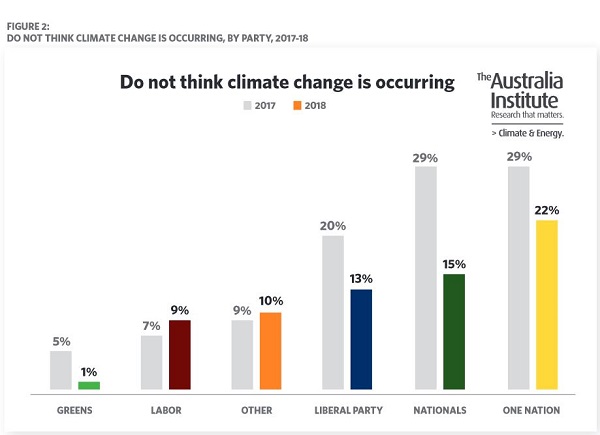
However:
Just over half (56%, 50% in 2017) of Australians believe that humans are the main cause of climate change.
It’s interesting that when asked, Australians think that support levels for human causation are less than half (47%).
This one shows how the level of concern about particular impacts has changed in just one year:
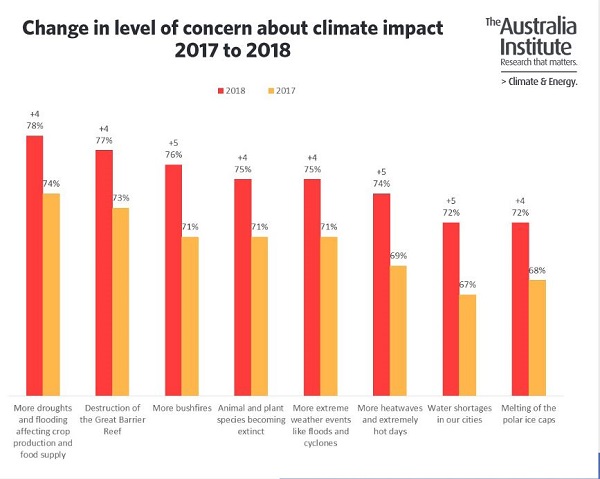
This table shows preferred energy source:
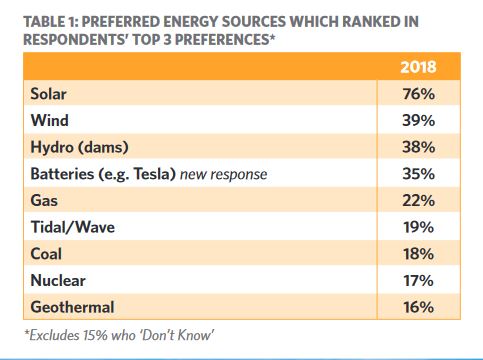
Three in five Australians (61%) prefer that coal-fired power stations be phased out gradually so that we can manage the costs over time (21% As soon as possible).
Here’s what ‘gradual’ means:
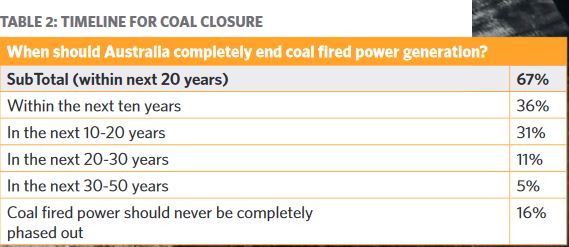
The questions about phasing out coal mining are new – public awareness having been raised by the Stop Adani campaign. Here’s what people said:

Misconceptions about the size and value of the coal mining industry are stunning. This is what was reported under the heading:
Australians overestimate the size of the
coal industry
- Australians significantly overestimate the size of the coal mining industry, both in terms of employments and its contribution to GDP. Excluding half (48%) of Australians who said they didn’t know, on average, Australians believe that coal mining makes up 8.8% of the workforce in Australia. That would be about 1.2 million workers out of Australia’s 13.3 million-strong workforce. In reality, coal mining is a relatively small industry in terms of employment, with 46,495 workers. On average, Australians believe that coal mining contributes 10.9% to the GDP of Australia. (This excludes 52% who don’t know). In reality, it contributes 1.0%.
So we think that employment in the industry is 25 times more than it is, and that it contributes almost 11 times more to the economy than it does,
This is what we think of what we should do about the Paris Agreement:

Apart from One Nation and the 25% who don’t know or are not sure, support is pretty solid – even the 76% of LNP voters who have an opinion split 47-28 in favour of staying.
The report concludes:
- Australians are increasingly concerned about the impacts of climate change, particularly the effects of rising temperatures, heatwaves and extremely hot days and they do not believe government is doing enough on climate change.
They blame electricity companies, privatisation and federal government policy uncertainty for electricity price rises and they support an orderly transition away from coal-fired power. More people disagree that coal has a strong economic future than agree and they would prefer that governments invest in renewable energy infrastructure over gas and coal, when spending taxpayers’ money.
Despite a decade of policy uncertainty and leadership turmoil, Australians back strong climate action and a majority want Australia to play a leading role when it comes to climate action, not wait for others to act. It is a message our elected representatives would do well to listen to as we head towards the next federal election.
Meanwhile our governing party continues to live in an alternative reality. Here’s the latest from RenewEconomy:
This is what Taylor wrote in the AFR today:
We won’t accept Labor’s 45 per cent Emissions Reduction Target and 50 per cent Renewable Energy Target. Their plan to take the failed South Australian experiment national will take a wrecking ball to our economy.
The situation is dire enough without interventions that will drive up prices and drive down reliability by prematurely driving out coal and gas.
Australians have had enough of unaffordable power bills driven by Labor’s virtue signalling, and of corporate greed dressed up as saving the planet. It’s time to go back to basics and put customers first.
I wonder what Angus Taylor and his ilk think of the extraordinary run of severe weather events we’ve been having around the world lately. I’ve recently come across my post of April 2016 – Hansen worries that all hell will break loose. Attribution studies will no doubt soon tell us.
Problem is, they do get a few hurricanes in places like North Carolina. A quick search says since 1851, 47 hurricanes have made direct hits there. However, together with sea level rise these storms are becoming a tad problematic. I think these images come from Hurricane Matthew in 2016:
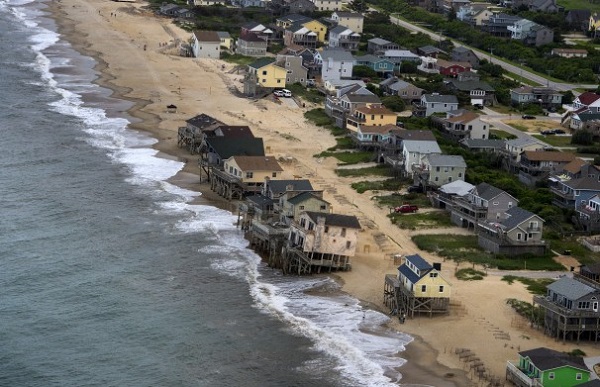
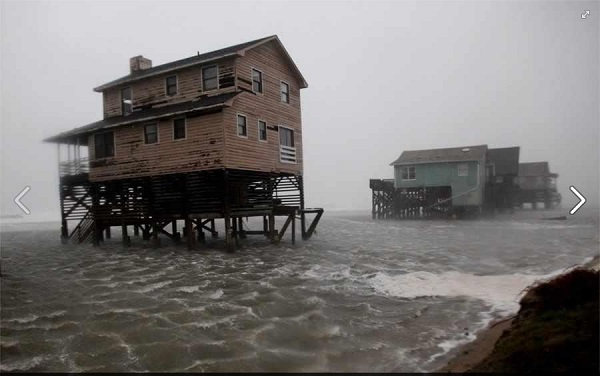
The standard position of people like Taylor, who has more than a few like him in North Carolina, is that, yes the climate is changing but it’s all due to sun spots and cosmic rays – or something.
Problem is that on a risk management basis they have to be 99.99999% sure that they are right and that all those scientists are wrong. Otherwise to say that they are being irresponsible is an understatement of epic proportions.


Yesterday, at RenewEconomy, the article headlined Japan’s Marubeni deals “body blow” to coal, in pivot to renewables by Sophie Vorrath, begins with:
And also:
IEEFA’s July 2018 report: Marubeni Corp had more than 12GW of new coal fired power plants under development globally, in Japan and across a range of emerging markets like Botswana, Egypt, Mongolia, Vietnam, Thailand, Indonesia and Myanmar.
Brian,
Federal Minister Angus Taylor wrote in the AFR today:
I have no doubt Angus Taylor has this bit right, but remind me which party has been in federal government since 7 September 2013? Oh, that’s right – the COALition! Methinks the “unaffordable power bills” are down to a lack of an energy policy by a succession of governments, including the current federal COALition government.
But Labor isn’t currently the Federal Government – the COALition is. Methinks Taylor is blaming Labor for the federal COALition’s ineffective/impotent energy policy, and allowing “corporate greed” to manifest on the federal COALition’s watch.
So, pray tell, what has the federal COALition being doing for the last 5 years? Asleep at the wheel, perhaps?
And Angus Taylor says:
New coal and gas are significantly more expensive than new renewables – who’s being “driven by ideology or grand gestures” here?
Just by way of explanation, when I said “on a risk management basis they have to be 99.99999% sure that they are right and that all those scientists are wrong” it wasn’t an arbitrary number. Decimals tend to confuse me, but I was trying to express the risk as 1 in a million, hence seven digits.
One in a million is the standard we expect when we get on an aeroplane. You could argue that where the future of the habitability of the planet and the large-scale extinction of species are in play, we should expect an even higher standard.
I heard the other day that when the dinosaurs were wiped out 65 million years ago, the largest mammal on the planet was the size of a domestic cat. Evolution since than has given us elephants, whales, giraffes, monkeys, apes and us, inter alia. Worth preserving, I would have thought.
Energy Minister Angus Taylor has confirmed the Morrison government will not replace the renewable energy target after it peaks in 2020. See:
SMH, Sep 18, headlined Angus Taylor confirms government ‘won’t be replacing’ renewable energy target; and
The Guardian, Sep 18, Katharine Murphy, headlined Coalition won’t replace renewables target after it winds down in 2020.
Today at The Guardian, Katharine Murphy writes:
Mark Butler, branded Taylor the minister “for higher power prices and anti-renewables”.
The Federal Member for Capricornia, Michelle Landry, was on the local TV news up here in Adaniland this evening. She was on the warpath against those left-wing think-tanks. Wonder if they have settled, yet, on the date of the next Federal election? Her sincere faith and her hard work are admirable – but hard scientific evidence and hard economic reality are better.
Today the AFR has an article about power and gas companies looking for lawyers.
They’ve got a crazed energy minister with a big stick, threatening dismemberment, and a PM threatening a royal commission.
I suspect Mark Butler thinks a fair dinkum inquiry might find that Commonwealth policy, or lack thereof, has been a problem.
We don’t need a royal commission for that.
Brian (Re: SEPTEMBER 20, 2018 AT 12:14 AM):
Thanks for the link. You say:
It’s not just Commonwealth policy, or lack of one, but I would add some state governments have contributed to the mess also, with the selling off of government-owned generators and “polls and wires”. But you can’t sue for Ministerial decisions – so what’s the point?
No doubt about that. Rather than wasting time (and expense on parasitic lawyers) on the past, governments need to get on with the urgent/critical task of transitioning rapidly away from finite, depleting fossil fuels towards sustainable, affordable, zero-carbon emissions renewable energy technologies, to mitigate a growing existential threat to humanity.
actually it’s “poles and wires”…. if only politicians would pay more attention to poles rather than polls…..
Abigulous (Re: SEPTEMBER 20, 2018 AT 6:35 PM):
Well spotted, Ambi. Perhaps it was a Freudian slip?
Yesterday in the SMH is an article headlined ‘Worrying’: Companies’ reporting of climate risks goes ‘backwards’ by Ruth Williams. The article begins with:
The Guardian has a similar article headlined Australian businesses must do more to disclose climate change risks to investors, Asic says by Lisa Cox. It includes:
Why should listed companies be concerned by climate change risk when the current federal government appears to be unconcerned by Australia’s emissions?
Never tell a lady that her Freudian slip is showing.

Smooching up for subsidies I’d recon, or virtue signaling to try and prevent media attacks that could harm sales.
Why waste time, money and effort on another royal commission? There is evidence aplenty that privatizing the electricity industries was not only inefficient but probably downright criminal too. Just nationalize the whole damned lot and haul the culprits – and their lawyers – off to re-education centres No sense in clogging up the jails – so are the facilities at Woomera and Port Hedland still available?
Graham, I thought it was interesting and encouraging the Shorten and Butler were talking about the negatives of privatisation. We are used to the situation where both sides have drunk deep on the ideology of privatisation.
Geoff M the AFR also had an article about companies neglecting to report on climate change issues.
Paul Beckwith may be a little dry but the actual information should make any rational person want to strangle a conservative politician a day.
https://youtu.be/E-QfKjOzfFg
A new satelite to study ice masses has just been launched to replace a key failed satelite and will improve the certainty of the ice loss information. It amazes me that the one thing in zero doubt is that of polar ice loss and yet it is is the lowest concern indicator in the bar graph above.
The biggest threat to our future lives right now is the Arctic Polar ice loss and the rapid thaw of the Northern Permafrost with the subsequent massive methane releases. This is the tipping point now well under way.
We fail to understand this and ignore it at our peril.
Yacht vloggers documenting climate change. Mahler and Johan has sailed to Alaska and are cruising the sounds. Water temperature 13C and retreating glaciers.
https://youtu.be/UOjToKsy2Bg
Rick on SSL is visiting the devastation of Hurricane Maria on Dominica.
https://youtu.be/OCiyhqefsv0
I wonder if there are any Winnebago vloggers with footage of our droughten West?
BilB, on my to do list is that new study on tipping points that came out recently. I gained a lot of attention with the phrase “hothouse earth”. It’s worth a closer look, when I get to ut.
From another Youtube, Brian, comes the information that the warmer climate, mostly in the form of humidity for extended periods (hence dangerous to humans), causes insects to evolve very rapidly amongst many other unforseen undesirable impacts that no one is going to like.
Lots of people don’t understand that, in terms of the top temperature that people can’t survive in that it can be the wet bulb temperature that kills. We cannot survive wet bulb temperatures above 35 deg C.
I have worked in dry bulb temperatures of at least 47 deg in the shade without noticeable problems while the air is dry enough to evaporate all the sweat. However, your body has a limited capacity to absorb water. There is a limit to the amount of time you can last if water absorption cannot keep up with water loss rate. There were times in the pilbara when I felt that I could not drink fast enough to remain comfortable. Wetting clothing and hats helped because this water could provide evaporative cooling without having to go through your body.
There’s a new report out from the Grattan Institute titled Who’s in the room? Access and influence in Australian politics. The Overview begins with:
Worth a look.
On Sunday (Sep 30), ABC Insiders programme contained an interview with Prime Minister Scott Morrison. This exchange segment caught my attention (time interval as per podcast):
Wasn’t the COALition in this current parliamentary term trying to get rid of ARENA and the RET, and attempted to redefine new HELE coal-fired power stations as sufficiently “clean” for the CEFC to invest funds in? I think ScoMo was performing a consummate ‘spin’ job in the Insiders interview, and Barry Cassidy let ScoMo continue unchallenged too often.
ScoMo also says he’s “comfortable” with “our 26%” target. Barry Cassidy didn’t advance the existential risk of dangerous climate change, with the stark scientific reality of humanity’s actions currently committing our world on a trajectory to 3–5°C of warming within this century, providing an adverse outcome that would either annihilate life, or permanently and drastically curtail its potential. Apparently ScoMo is “comfortable” with that consequence; an example of moral hazard permeating official thinking in the interests of perceived short-term political expediency.
On Labor’s 45% emissions reduction target (at time interval 23:29), ScoMo says: “Now we all know what that will do – it will put up electricity prices by $1400 for every household in the country.”
ScoMo is still trotting out this apparently bogus $1400 figure and embellishing it further by stating the increase is “for every household in the country”. Barry Cassidy did not challenge ScoMo to substantiate the “$1400” figure and what it’s based upon. When are some journalists going to do their jobs properly by being well briefed on the critical issues and challenge phoney statements? Stop giving these people an easy ride at our nation’s expense and risking Australia’s long-term national security.
Last week in The Guardian, Katherine Murphy in her article headlined Business council faces negative ad blitz over criticism of 45% emissions target, included:
It’s about time someone challenged the garbage being put about as “fact” and serious debate on energy policy.
Agree.
I have to go to work now, but have a new climate post, should be up later tonight and am planning a few more. Need to get back to it after distractions of changing PM, Serena and ABC.
PM
It will put up power prices by $1400 for every household in the country.
May I just comment, Mr Prime Minister?
Thanks.
We didn’t all come down in the last shower.
We voters and householders have been thinking about our power bills, reducing our power use, paying attention to the “star ratings” of new white goods, getting to know which appliances use the most power, and chatting to neighbours and friends about our power bills.
Heck, some of us have switched electricity retailers, or gone hunting for discounts. I reckon all of us know that power prices vary from State to State, and that power use varies according to size of house, climate, etc.
So why do you think we’re going to swallow this balderdash about every household having an IDENTICAL rise in annual power bills???
It doesn’t make any sense.
D’ya reckon we’re all idiots?
Think we don’t look at our power bills?
(Just put them on direct debit and she’ll be right mate I’m a daggy Dad who loves the footy and wouldn’t know a dollar if it tripped me up on the way to the dunny?)
Fair suck of the sauce bottle, Mr Prime Minister.
Did you mean on average?
Well, say so then.
We can take it.
And if you’re predicting a national average, what are the State averages you predict, then? They must differ, Prime Minister. Even up and down my street power bills differ!
Who did the modelling, Mr PM?
How did they work it all out?
Or did someone do a bit of fancy air-plucking, where he grabbed a figure out of thin air? Or was it one of them ” back of an envelope” guesstimates with no error estimates??
Come on down Scotty, there’s intelligent life on the planet we live on, waiting for answers. You should visit us one day.
Cheerio
There’s an opportunity for Labor and Greens spokespersons* to seize on this nonsense.
Not with some kind of statistics lecture, just a bit of common sense.
* and business groups, power generators, heck: even engineers or academics could speak up, if they were game!
Ambigulous (Re: OCTOBER 3, 2018 AT 4:06 PM):
Check out today’s RenewEconomy article headlined Greens propose 30 renewable energy zones, backed by grid fund, that leads with:
And perhaps have a listen to the RenewEconomy Energy Insiders Podcast: Origin’s Greg Jarvis on why renewables are cheaper than coal.
The Australia Institute published Stay on Target last week.
It seems the COALition has it’s head in the sand, hoping most Australians aren’t so well informed.
It seems the $1400 figure has arisen from an article early last month in The Australian, by economics journalist Adam Creighton. See 2GB podcast interview with Adam Creighton here.
Enough said.
But even an economics journalist would be aware of variability, averages, non-uniformity, variation between households and differences between States abd regions…
wouldn’t he??
I’d like to believe that specialist journalists could be held to a high standard, no matter which newspaper they wrote for.
Ambigulous (Re: OCTOBER 3, 2018 AT 5:56 PM):
“Liking to believe” and what is reality can be different things.
The Australian article by Adam Creighton headlined Engineers warn of bill shock under green energy surge, dated Sep 5, includes two graphs attributed to Energy Power Consulting. The second graph headlined Cost and Emissions Comparisons doesn’t tally at all with the LCOE figures given in Lazard’s Levelized Cost of Energy Analysis Comparison – Version 11.
It seems that Adam Creighton is taking Energy Power Consulting (whom ever they may be) at face value without analyzing/critiquing and comparing the data supplied with other credible sources – whoops. But perhaps that would be inconvenient for the narrative that The Australian appears to be pushing?
Posted today at RenewEconomy is an article by Giles Parkinson headlined World’s biggest solar plus storage plant goes through final testing.
IT Power’s Keith Lovegrove, one of Australia’s leading solar thermal experts – among others – was given a guided, and by the looks of things sometimes not-so-guided, tour of the 150MW Noor 3 solar tower complex, in Morocco.
The article included:
SolarReserve’s South Australian project Aurora 150 MW concentrated solar thermal generator with 8 hours storage is proposed to be very similar to Noor 3.
Geoff M
Oct 5th at 1.08pm.
Good detective work.
I believe that consultants’ report was sent to Federal Cabinet members, and it’s the source of the $1400 annual cost figure.
When I found the article the very first line said “an average increase of $1400 per household”.
So Mr Scott Morrison’s saying “EVERY Australian household will be paying $1400 more each year” is an incorrect quoting of the report, regardless of that report’s provenance and the assumptions its authors made.
You’d think the Federal Treasurer would understand
averages
wouldn’t you?
Jeepers.
I hope he never becomes PM.